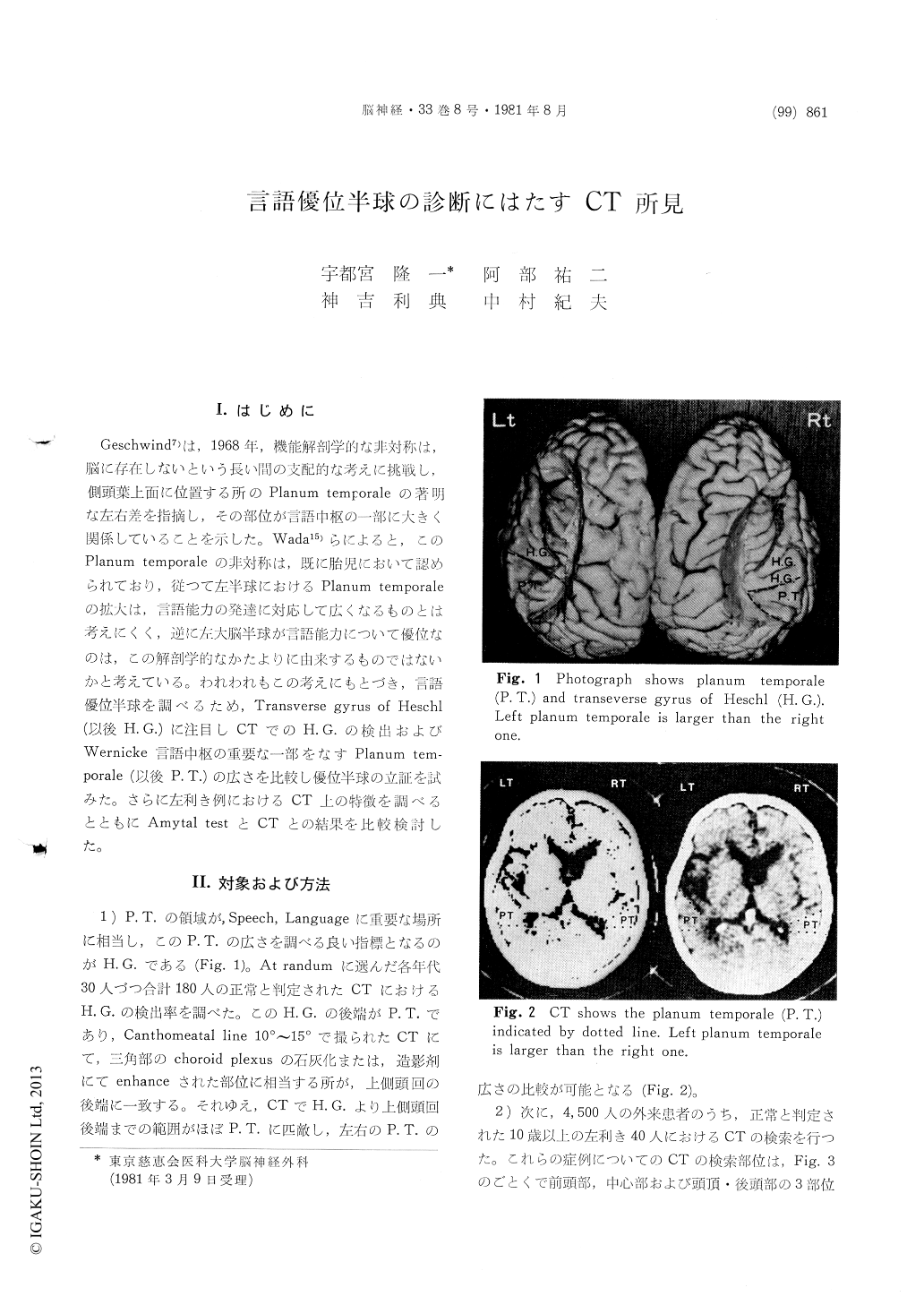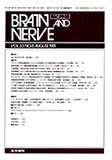Japanese
English
- 有料閲覧
- Abstract 文献概要
- 1ページ目 Look Inside
I.はじめに
Geschwind7)は,1968年,機能解剖学的な非対称は,脳に存在しないという長い間の支配的な考えに挑戦し,側頭葉上面に位置する所のPlanum temporaleの著明な左右差を指摘し,その部位が言語中枢の一部に大きく関係していることを示した。Wada15)らによると,このPlanum temporaleの非対称は,既に胎児において認められており,従つて左半球におけるPlanum temporaleの拡大は,言語能力の発達に対応して広くなるものとは考えにくく,逆に左大脳半球が言語能力について優位なのは,この解剖学的なかたよりに由来するものではないかと考えている。われわれもこの考えにもとづき,言語優位半球を調べるため,Transverse gyrus of Heschl(以後H.G.)に注目しCTでのH.G.の検出およびWernicke言語中枢の重要な一部をなすPlanum tem—porale (以後P.T.)の広さを比較し優位半球の立証を試みた。さらに左利き例におけるCT上の特徴を調べるとともにAmytal testとCTとの結果を比較検討した。
The functional asymmetries of the human brain might well be correlated with anatomical asym-metries. Geschwind pointed out striking anatomical asymmetries between the operculum of the human right and left temporal lobe. The planum tempo-rale is larger on the left in 65 percent of brains, on the right it is larger in 11 percent. This area makes up part of the temporal speech cortex, whose availability is well established on the basis of both clinical and experimental studies. The enlargement of the left planum temporale cannot be an impactto the development of linguistic ability in child-hood. The superior linguistic talent of the left hemisphere may result from the anatomical bias. From the point of this concept, the detectability of cerebral dominance on CT is investigated. And comparative study is performed between amytal test and CT for the determination of cerebral dominance.
Materials and method
1) The demonstration of Heschl's gyrus is availa-ble to identify planum temporale, which forms part of Wernicke's speech area. This area behind Heschl's gyrus on the right and left constitutes planum temporale. The subjects consisted of 180 controls from second to seventh decade to demon-strate Heschl's gyrus on CT.
2) Comparative width measurements of the fron-tal, central and parieto-occipital portions of the hemispheres on CT were made in 40 left handers and 100 right handers above the age of ten years. Each portion of width measurements is illustrated in Figure 3. Characteristic CT findings in left and right handers are also discussed.
3) Comparative study is evaluated between amy-tal test and CT for the determination of cerebral dominance for speech.
Results
1) The demonstration of transverse gyrus of Heschl (H. G.) on routine CT examination was in-creased in direct proportion to the age.
The planum temporale is larger on the left in 77 percent of 180 controls, on the right it is larger in 23 percent.
2) Left handers comprise 1.98% (89 persons) out of 4500 outpatients. 40 healthy left handers (25 males and 15 females) above the age of ten years were investigated.
Three left handers (8.2%) out of 40 presented the right planum temporale to be larger than the left. 75% of left-handed individuals showed theleft planum temporale to be larger than the right. The planum temporale was equal in 17 percent.
In left-handed person the left frontal lobe was wider or equal than the right (82.5%), and right parieto-occipital lobes were wider than the left (62.5%) as shown in Figure 5. The width of frontal and parieto-occipital lobes exhibited reverse tenden-cy in right handers compared to left handers.
3) 11 males and 6 females verified cerebral domi-nance by amytal test showed 13 right and 4 left handers. Two right-handed indivisuals and 4 left-handed persons out of 17 verified the lateralization of cerebral dominance by amytal test presented in the right, and the remainder showed in the left. CT was taken in 15 out of 17 amytal cases. Availa-bility of comparative studies between CT and amytal test were possible in 15 cases out of 17. And satisfactory results for the lateralization of cerebral dominance were obtained among them.

Copyright © 1981, Igaku-Shoin Ltd. All rights reserved.


